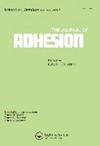粘结剂改性和层合板表面处理对碳纤维复合材料单搭接接头性能的影响
IF 2.3
4区 材料科学
Q2 ENGINEERING, CHEMICAL
引用次数: 2
摘要
摘要本研究采用拉伸剪切试验、SEM微观形貌表征、EDS能谱、载荷-位移曲线分析、失效模式和结合表面元素含量等方法,研究了胶粘剂改性、层压板表面处理及其对胶接性能的综合影响。与层压板的表面处理相对应的测试组表现出最佳的拉伸剪切性能。与使用320#砂纸仅进行表面抛光相比,使用20%NaOH进行表面处理可使拉伸剪切强度和破坏位移分别提高30.41%和106.72%。在粘合剂改性试验组中,用3wt.%的短玻璃纤维进行粘合剂改性后,接头的拉伸剪切强度最大,而与未进行粘合剂改质的接头相比,拉伸剪切强度和破坏位移分别增加了7.96%(18.63MPa)和10.2%。为了进一步提高玻璃纤维和粘合剂之间的润湿性和界面结合强度,用KH-550硅烷偶联剂对3wt.%的短玻璃纤维进行预处理。接头的拉伸剪切强度提高到19.06MPa,最大破坏位移为1.59mm,分别比未经KH-550硅烷偶联剂预处理的玻璃纤维高2.31%和2.58%。此外,通过KH-550处理的3wt.%短玻璃纤维的粘合剂改性与用20%NaOH的层压板表面处理相结合。粘合强度比使用用KH-550预处理的3wt.%GF粘合剂改性获得的粘合强度高,而与用20%NaOH对层压板进行表面处理对应的粘合强度相比降低了10.49%。这主要归因于NaOH和KH-550硅烷偶联剂之间的水解反应产生的孔隙,削弱了接头的承载能力。本文章由计算机程序翻译,如有差异,请以英文原文为准。
Effect of adhesive modification and surface treatment of laminates on the single lap bonding joint properties of carbon fibre composites
ABSTRACT In this study, the effects of adhesive modification, surface treatment of laminates, and their combined effects on the bonding properties of adhesive joints were studied using tensile shear tests, SEM micro-morphology characterisation, EDS energy spectra, analysis of the load-displacement curve, failure mode, and element content on the bonding surface. The test group corresponding to surface treatment of the laminate exhibited the best tensile shear performance. Surface treatment by 20% NaOH increased the tensile shear strength and failure displacement by 30.41% and 106.72%, respectively, compared to that obtained with only surface polishing using 320# sandpaper. In the adhesive modification test group, the tensile shear strength of the joint was the largest with an adhesive modification by 3 wt.% short glass fibres, while the tensile shear strength and failure displacement increased by 7.96% (18.63 MPa) and 10.2%, respectively, compared with those without adhesive modification. To further improve the wettability and interfacial bonding strength between the glass fibre and adhesive, a 3 wt.% short glass fibre was pretreated with KH-550 silane coupling agent. The tensile shear strength of the joint improved to 19.06 MPa, and the maximum failure displacement was 1.59 mm, which were 2.31% and 2.58% higher than those without KH-550 silane coupling agent pretreatment on the glass fibre, respectively. Furthermore, adhesive modification by KH-550 treated 3 wt.% short glass fibre was underwent combining with laminate surface treatment with 20% NaOH. The bonding strength was higher than that obtained using 3 wt.% GF adhesive modification pretreated with KH-550, while lower by 10.49% compared with that corresponding to the surface treatment of the laminate by 20% NaOH. This was primarily attributed to the pores produced by the hydrolysis reaction between NaOH and the KH-550 silane coupling agent, which weakened the load-bearing capacity of the joint.
求助全文
通过发布文献求助,成功后即可免费获取论文全文。
去求助
来源期刊

Journal of Adhesion
工程技术-材料科学:综合
CiteScore
5.30
自引率
9.10%
发文量
55
审稿时长
1 months
期刊介绍:
The Journal of Adhesion is dedicated to perpetuating understanding of the phenomenon of adhesion and its practical applications. The art of adhesion is maturing into a science that requires a broad, coordinated interdisciplinary effort to help illuminate its complex nature and numerous manifestations.
 求助内容:
求助内容: 应助结果提醒方式:
应助结果提醒方式:


